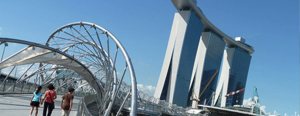 This summer, the Vancouver Art Gallery is featuring an exhibit called Grand Hotel: Redesigning Modern Life. The exhibit charts the evolution of the MGM Grand Hotel from an isolated and utilitarian structure to a world renowned cultural phenomenon. The show takes visitors through the evolution of hotel uses and design, and notably ends with the exceptionally contemporary Marina Bay Sands in Singapore.
This summer, the Vancouver Art Gallery is featuring an exhibit called Grand Hotel: Redesigning Modern Life. The exhibit charts the evolution of the MGM Grand Hotel from an isolated and utilitarian structure to a world renowned cultural phenomenon. The show takes visitors through the evolution of hotel uses and design, and notably ends with the exceptionally contemporary Marina Bay Sands in Singapore.
This $5.7 billion mega-scale project is incredibly complex, combining bridge design and building technology. As Asia Pacific’s largest integrated resort, Marina Bay Sands possesses a distinct identity which has distinguished Singapore from other cities. This project was also built on reclaimed land, and surrounded by seawater, making the below grade concrete susceptible to damaging corrosion. Kryton’s distributor in Singapore (Lee Construction Pte Ltd.), was approached by the project team, to find a sole waterproofing product that could address numerous concrete waterproofing issues.
 Challenges included:
Challenges included:
- Tight construction timeline
- Multiple contractors working on the site
- An easy, efficient application, and permanent system
- Close proximity to salt water
- System must be able to withstand significant hydrostatic pressure - deepest point is 25 meters (82 feet) below grade
Lee Construction presented Kryton’s Krystol Internal Membrane (KIM) as the perfect option. By simply adding KIM to the concrete mix at the time of batching, waterproofing concrete becomes a quick and easy process that won’t hold up the construction timeline. The Krystol system uses advanced integral crystalline waterproofing technology to transform porous concrete into a permanent, water-resistant barrier and provide a guaranteed defense against water damage and steel reinforcement corrosion. If cracks later form, the incoming water will react with KIM and trigger further crystal growth, filling cracks and keeping the structure watertight.
Marina Bay Sands opened on April 27th, 2010 and has seen 19.6 million visitors walk through its doors in its first year of operations. It remains a landmark for the city of Singapore, as a symbol of contemporary culture.







